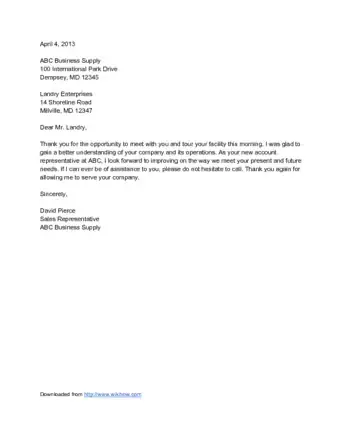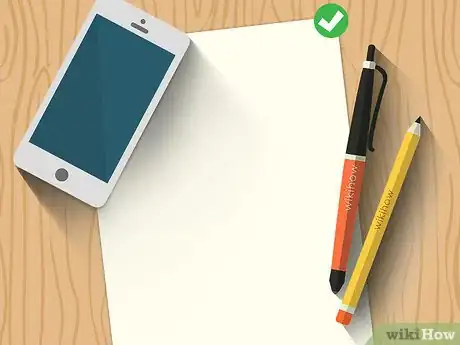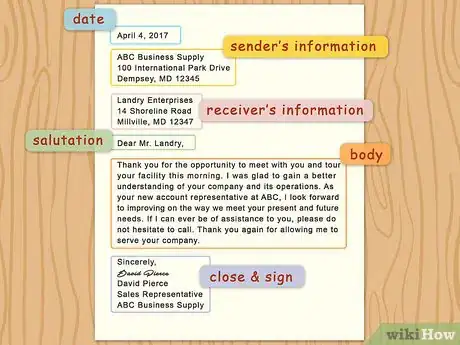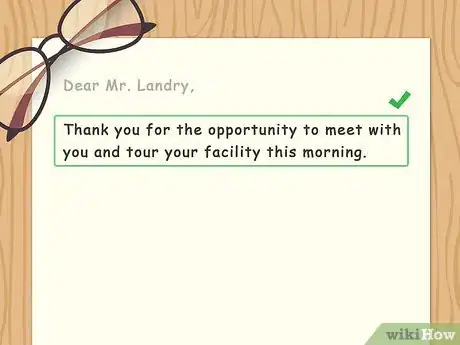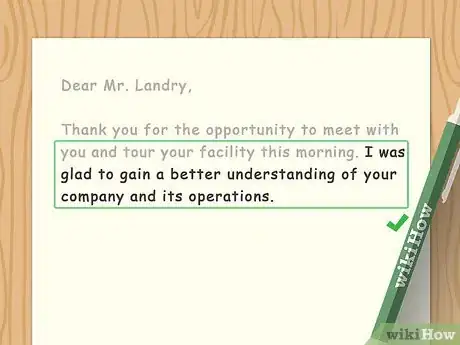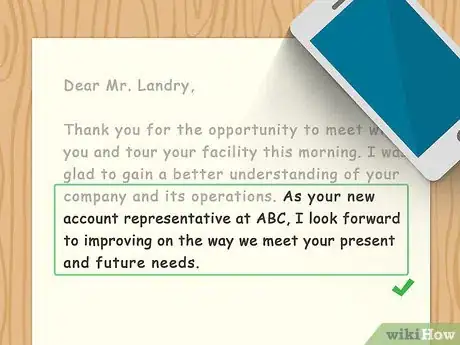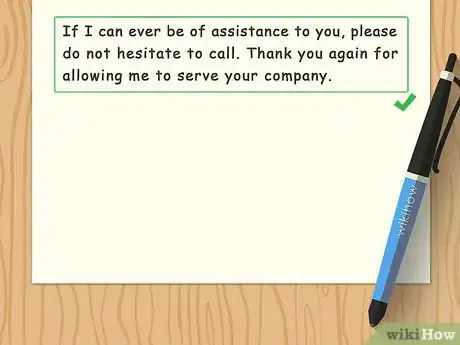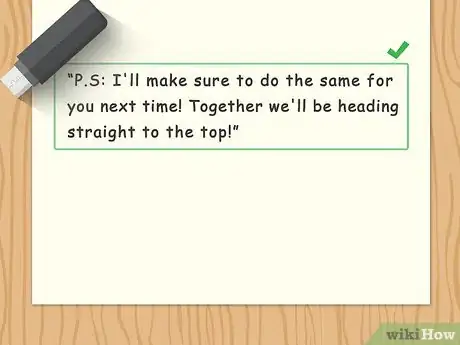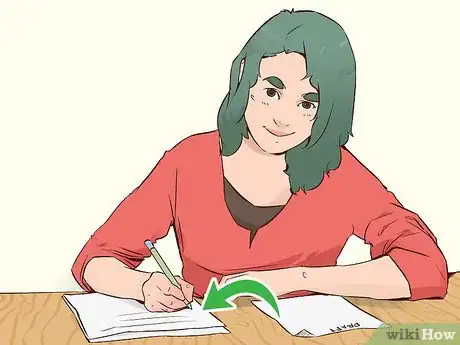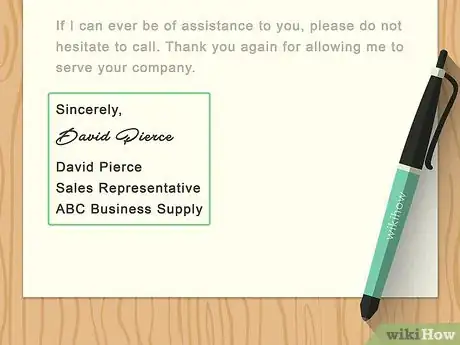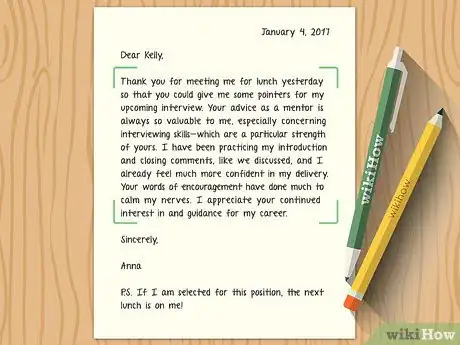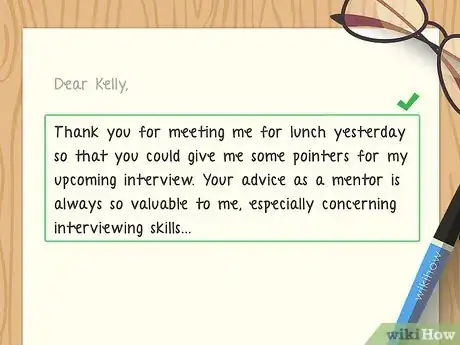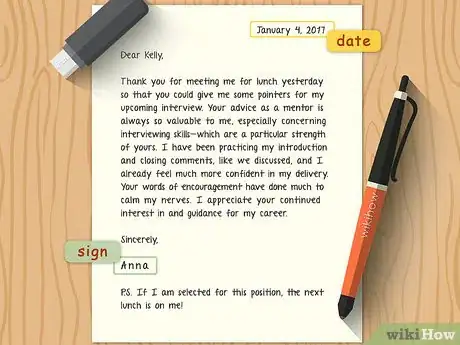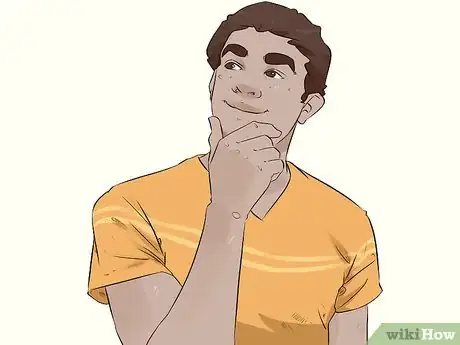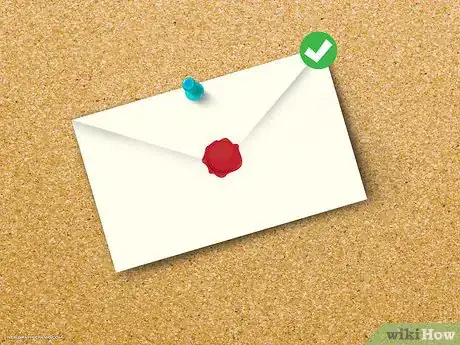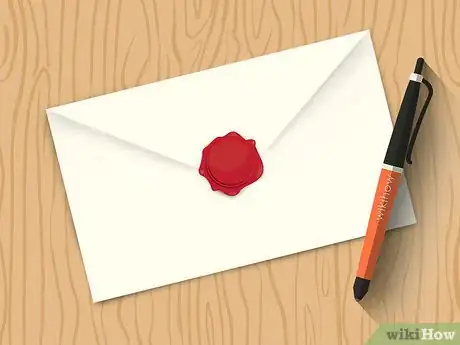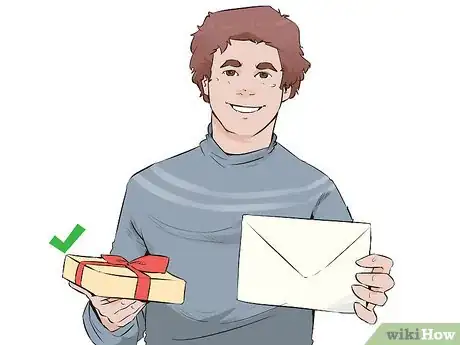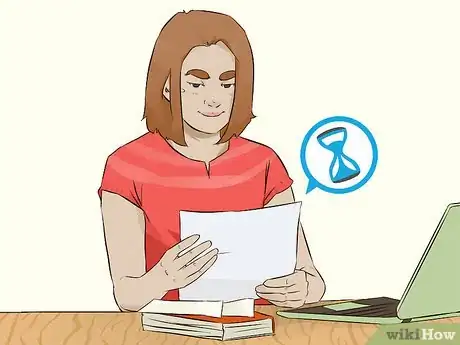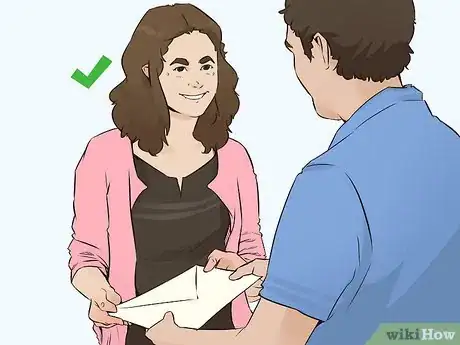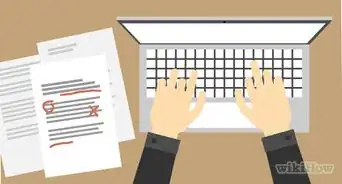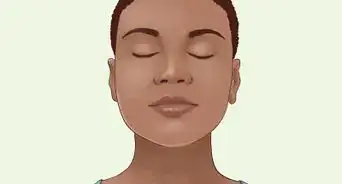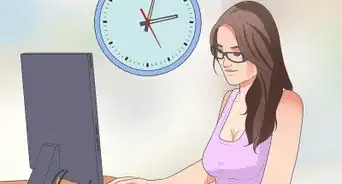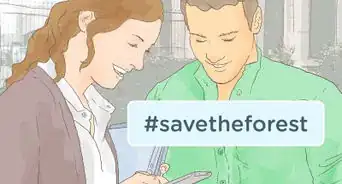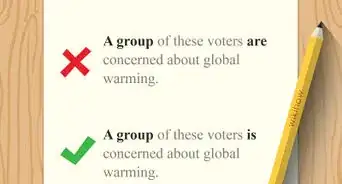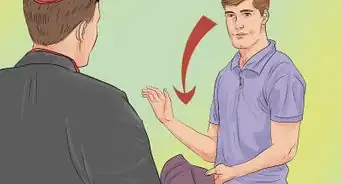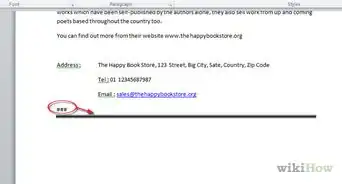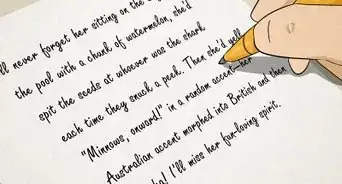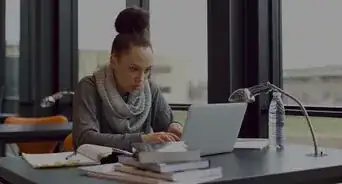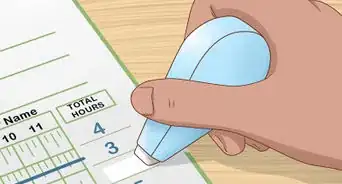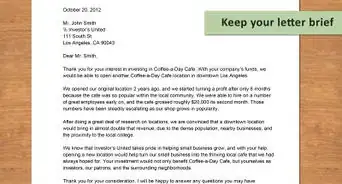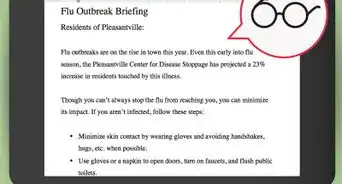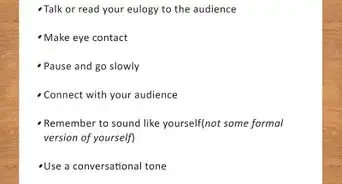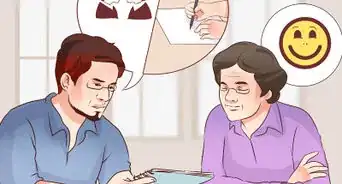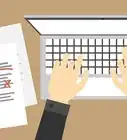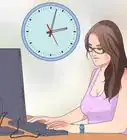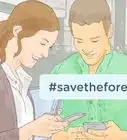This article was co-authored by Tami Claytor. Tami Claytor is an Etiquette Coach, Image Consultant, and the Owner of Always Appropriate Image and Etiquette Consulting in New York, New York. With over 20 years of experience, Tami specializes in teaching etiquette classes to individuals, students, companies, and community organizations. Tami has spent decades studying cultures through her extensive travels across five continents and has created cultural diversity workshops to promote social justice and cross-cultural awareness. She holds a BA in Economics with a concentration in International Relations from Clark University. Tami studied at the Ophelia DeVore School of Charm and the Fashion Institute of Technology, where she earned her Image Consultant Certification.
This article has been viewed 1,143,376 times.
Compared to most other types of thank you letters, a professional correspondence can prove nerve-wracking to write. Professional letters are expected to be formal, and choosing the right combination of words can sometimes even mean the difference between getting a new career advancement or not. Showing gratitude is an important part of getting ahead in the workplace. Whether you're writing a letter to get an advantage or simply want to show you appreciate it, there are lots of things you can do to make your professional thank-you note the best it can be.
Steps
Sample Thank You Notes
Writing A Professional Letter
-
1Use high quality paper. Even for brief thank-you notes, the type and quality of paper can say a lot by itself. Professional letters should be printed on a strong grade of paper that won't accidentally tear. On the other hand keep in mind that a more simple note or memo isn't expected to be as formal, so you needn't worry about going out of your way to buy the very best if it's not available. [1]
- In the case of a simple, short note, you should make sure the paper is small too. A few sentences scrawled on a big sheet of paper will look uninvolved. Post-it notes are usually small and perfect for quick thank-you notes.
-
2Adhere to a business letter format. As opposed to a quick note, a professional letter tends to be leagues more formal and serious. This entails sticking to pre-defined guidelines for letter writing. [2]
- Include your name, the date and the addressee at the top of the letter.
- Type using a standard font (such as Times New Roman) and size (12).
- Include your signature at the bottom. This will give even a typed letter a personal touch.
Advertisement -
3Specify your reasons for thanking in the first sentence.[3] Although you will have more opportunity in a longer letter to go into detail, like the short note, you will still want to economize on what you're saying. In the first sentence or two, clearly state that you are thankful and why you are thankful. Due to the effort involved in writing a letter, it should be understood that the help will have been significant as well. If you think the person involved meant the difference between your success and failure, it's a good idea to write a letter.
- Compared to a simple note, you can go into more detail about what you're thankful for with a professional letter, and explain how their part has benefited you. For example, if he vouched for you at a meeting, you can expand upon your gratitude by noting all the career doors their support has opened for you.
- For example: "I am writing to thank you for the help you offered at the board meeting today. The advice would offered to me beforehand proved invaluable, and the professionalism, work ethic and integrity you exhibit on a daily basis is a true example for the rest of the company to follow.""
-
4Stress the importance the recipient's help has had.[4] Although your letter should still be a few paragraphs at max, you should still make sure to repeat points of interest, most notably your gratitude and the importance. Giving the recipient a feeling of personal importance will make him that much more likely to help you again in the future.
- For example, if the recipient helped you through openly vouching for a project idea of yours, you can explain specifically how that will help you in the long run: "Thanks to you vouching for me, I'll have my chance to show what a capable and innovative worker I am. I am confident that this tentative project will be a great success, and I am certain they'll want to see a lot more of me once it's done!"
-
5Mention an openness for future aid and communication towards the end of your letter. In a letter, it's important to leave the door open for future correspondence. Stressing that you would like to continue and develop a professional relationship with them will add substance to your gratitude, and make the recipient feel like his help has been taken to heart.
-
6End with a reiteration of thank you. The first and last thing the recipient reads will be the most memorable parts of the message, so it's important to end the message with another thank you before your name. Keep the thank you formal, but don't be afraid to dress up the gratitude a bit. For example, writing "A thousand sincere thanks!" sounds more impassioned than a basic "Thank you". [5]
-
7Add a P.S. at the end if you're on personal terms. If you and the recipient are friends or connected in some way beyond a purely professional capacity, adding a P.S. at the end with a less formal greeting is a great way to add warmth to an otherwise austere correspondence. If the person knows you well enough, you'll want to let your personality shine through. [6]
- For example: "P.S: If this interview goes through, I'll buy us a round at the pub this weekend!
- Or, if you and the recipient are on equal footing in the career hierarchy: "P.S: I'll make sure to do the same for you next time! Together we'll be heading straight to the top!"
-
8Complete a first draft, then edit and re-do. A good professional letter will take much longer to plan than to write. Writing a second version will take a fraction of the time as the original, and on your second time around you'll be able to make it as good as you want it to be. Decide what parts of your letter you like the most, and do without the weaker elements, replacing them instead with sentences and ideas you think will best convey what you're trying to say.
- If you're having any confusion regarding whether your letter works or not, try reading it out loud. You'll find reciting the letter (or any written document, for that matter) will bring attention to issues and areas for improvement you wouldn't normally pick up from reading alone.
-
9Print onto good paper and sign your name. Once you've finished the draft, you should print it off as soon as possible and give it your signature in pen. Even with a typed document, you still want to give it a personal touch. A good way to cap off a professional letter is to type your full name, then make your pen-made signature right below it.
Writing A Simple Note
-
1Keep your writing brief. Unlike a full-bodied professional letter, a simple note is not likely to be more than a few sentences in length. This means you have to economize on what you have to say. Get right to the point with your message. You don't need to be near as formal here, so you can dispense with a lot of the traditional formatting, so long as you remember to state your name, and to whom you're writing.
- Using a pen with legible handwriting is preferable in this case.
-
2Specify why you're thanking and how the recipient's help has benefited you. In a short thank-you note, you'll have to economize on the amount of things you want to say. While making sure to say thank you is the most important thing, it's just as vital you specifically state why you're thanking the person, and how you'll put the recipient's help or advice to good use.
- For example, if the recipient gave you advice on an upcoming job interview, you can say: "I'd like to thank you for all the advice you imparted regarding the interview. I'm going to keep it in mind while I'm preparing for it; I'm confident it will help me land the job!"
-
3Include your name and date somewhere in the note. Even if a post-it thank-you note is relatively informal, you shouldn't go without giving the name and date. Particularly if the individual is very busy, it may not be clear who sent the message without a name. Adding a date also helps to give the note more context and professionalism.
- If space on the page is an issue, you can just go the formal route and write the date in shorthand (e.g. 09/27/15).
Delivering the Note
-
1Decide how important and formal the letter is, and deliver it accordingly. It would be silly to seal a two sentence thank-you memo in an envelope and formally present it to the recipient. On the other hand, you might come off as rushed or even lazy if you deliver a formal letter carelessly.
-
2Post it somewhere visible. The best way to give a smaller thank-you note is to put it somewhere he will normally go. Personally handing someone a thank-you note will come off as redundant, so it's best for the recipient to see it when you're not around. For example, if it is a fellow co-worker, you could attach it to his cubicle as soon as you get to work. Another opportunity would be to be to stick it to the recipient's door.
- Although it's not a likely risk in a professional note, it's a good idea to exercise some discretion with a note. Assume that anyone could potentially read it, especially if you're leaving it in a high-traffic area like the office space. If there is any doubt, it's best to seal your letter in an envelope.
-
3Seal your letter in an envelope. Unlike a simple note, which is more informal and spontaneous, giving a letter can involve some ritual and formal courtesy. Feel free to seal it in an envelope and place it in their inbox, or even hand it to them personally. If you give it personally, make sure to bolster the letter with a smile and a firm handshake.
-
4Attach a minor gift if appropriate. In some cases, it may be appropriate to attach something inexpensive (>$10) to the note as a way to better manifest the gratitude. Take care only to do this when it is appropriate however; you don't want to make it look like you're trying to bribe someone. [7]
- If you attach a gift, it is best to deliver the letter and gift personally.
-
5Wait until an appropriate, quiet time if you choose to deliver the letter personally. It's not recommended you personally give a short note to someone personally, but a bigger letter (especially when coming with a gift) may be appropriate depending on the circumstances. If you decide it's best to give it to the recipient directly, you should keep surrounding circumstances in mind. If the recipient is bogged down with work, he might be annoyed by any new distractions. Waiting until a lunch break or a lull in the day's busyness is a good time to hand it over.
-
6Be polite and gracious while delivering your letter. You would give very mixed messages if you don't personally show the same gratitude you wrote in your letter. This is especially true if you have written the letter purely as a professional gesture. If and when you deliver the letter, you need to make sure your personal behaviour is in line with the meaning of the letter. Be confident, and remember to smile.
- If you're feeling anxious, take a moment to remember the fact that very few people have felt anything other than gratitude and satisfaction for being thanked for something!
Community Q&A
-
QuestionHow do I thank a patient after visiting our website?
 Tom De BackerTop AnswererThis is not necessary. You could write a "thanks for visiting" sign on your homepage, but even that is not necessary. If you're thinking of e-mailing them, don't. It's annoying, because if they visit your site every day and get an e-mail every day, it's counterproductive. The same goes for a pop-up when they leave, and a mouse-over pop-up when they are about to click the x, it's just annoying. Plus, you don't need to thank them on this occasion. They came, read, left, nothing special about that.
Tom De BackerTop AnswererThis is not necessary. You could write a "thanks for visiting" sign on your homepage, but even that is not necessary. If you're thinking of e-mailing them, don't. It's annoying, because if they visit your site every day and get an e-mail every day, it's counterproductive. The same goes for a pop-up when they leave, and a mouse-over pop-up when they are about to click the x, it's just annoying. Plus, you don't need to thank them on this occasion. They came, read, left, nothing special about that. -
QuestionWhat do I write when someone accepts my business meeting?
 Tom De BackerTop AnswererThere is no need to write anything in this moment in the process. You have a need to meet, you send the invites, they accept. The next step is to actually meet. You will have an opportunity to say something at the start of the meeting: "Thank you for taking the time to attend this meeting." Most professionals receive dozens (if not hundreds) of e-mails a day. Your thank-you-for-accepting-my-request e-mail adds no value, it only annoys, because it has no content and is thus a waste of time.
Tom De BackerTop AnswererThere is no need to write anything in this moment in the process. You have a need to meet, you send the invites, they accept. The next step is to actually meet. You will have an opportunity to say something at the start of the meeting: "Thank you for taking the time to attend this meeting." Most professionals receive dozens (if not hundreds) of e-mails a day. Your thank-you-for-accepting-my-request e-mail adds no value, it only annoys, because it has no content and is thus a waste of time. -
QuestionShould I write a response to an email sent to me stating that they have received by application and will follow up with me in the fear future? If so, how should I respond?
 Tom De BackerTop AnswererNo, a response is not required. The letter itself is a terminal letter, it says, "Thank you [and here ends this conversation]". They have already said that they will contact you. That means they keep the ball in their court, and they have reserved the right to be the first to initiate the next phase of your conversation. At most, set a reminder for a few weeks and then kindly follow up yourself.
Tom De BackerTop AnswererNo, a response is not required. The letter itself is a terminal letter, it says, "Thank you [and here ends this conversation]". They have already said that they will contact you. That means they keep the ball in their court, and they have reserved the right to be the first to initiate the next phase of your conversation. At most, set a reminder for a few weeks and then kindly follow up yourself.
Warnings
- Make sure your thank-you message is appropriate. You don't want to send too many thank-you letters, lest they lose their effect. Nor do you want to write a letter for something meagre and trivial. If the other person has gone considerably enough out of their way to help you however, acknowledgement and gratitude never hurt.⧼thumbs_response⧽
References
- ↑ https://www.readingrockets.org/article/introduction-letter-writing
- ↑ https://writing.wisc.edu/handbook/assignments/businessletter/
- ↑ Tami Claytor. Etiquette Coach. Expert Interview. 29 September 2020.
- ↑ Tami Claytor. Etiquette Coach. Expert Interview. 29 September 2020.
- ↑ https://hbr.org/2021/11/how-to-write-a-meaningful-thank-you-note
- ↑ https://hbr.org/2021/11/how-to-write-a-meaningful-thank-you-note
- ↑ https://positivepsychology.com/how-to-express-gratitude/
About This Article
Writing a professional thank-you note can be a thoughtful way to advance your career. Structure the thank-you note like a formal letter, by placing the date at the top of the page, followed by your information, the recipient’s information, and a formal salutation. Next, write the body of the thank you note, specifying the reason for the letter in the first sentence. Stress the importance the recipient’s help has had. Finish with a formal closing and your signature. Keep reading to learn whether to send a letter or if a simple note is more appropriate!

